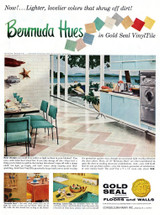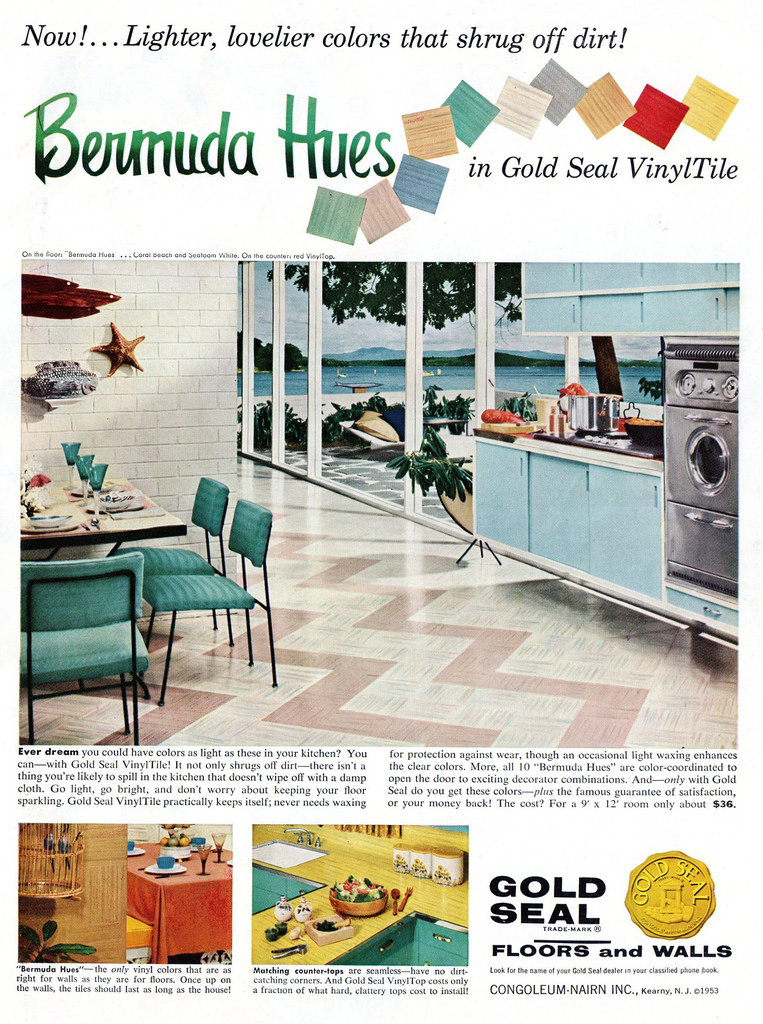Vinyl Flooring


|
Vinyl flooring was invented in the 1920’s, but really came to prominence in the housing boom after World War II because it was an easily installed, durable, cheap flooring alternative to linoleum. As a flooring option, vinyl flooring is now second only to carpet in the U.S. Vinyl is predominantly sold in three main forms for both residential and commercial use: large rolls of sheet vinyl, vinyl tile and vinyl plank flooring. |
 One of the main reasons people select vinyl over the varieties of
hardwood flooring and laminate flooring is its durability. Vinyl is widely used commercially because it is not just water resistant, but often is a fully waterproof flooring. This
makes it the best choice for kitchens, bathrooms and basements. One of the main reasons people select vinyl over the varieties of
hardwood flooring and laminate flooring is its durability. Vinyl is widely used commercially because it is not just water resistant, but often is a fully waterproof flooring. This
makes it the best choice for kitchens, bathrooms and basements.
It is also extremely stain, dent, and scratch resistant. Vinyl flooring is made of shock absorbent materials. In addition to adding to its ruggedness, this adds to the walking comfort. Vinyl floors can be easy to stand on, even for long periods of time. They are often backed with a layer of foam or felt, which makes them both safer, and quieter, to walk on. Vinyl flooring falls under the heading of “resilience flooring” because of its tendency to bounce back into shape after being compressed, whether by feet or furniture. That feature also suppresses sound. |
The very same qualities which make vinyl flooring durable also make it very easy to clean and to care for. Because there are no pockets or grooves, vinyl will not collect dust, dander or other allergens, and its moisture resistance keeps it from being a habitat for mold. Many vinyl floors even have anti-bacterial elements manufactured into them. Usually all you have to do is damp mop the floor as needed.

|

|

|
| Because it can be a printed floor, vinyl can have an almost unlimited number of design, style, pattern and color options. It can match the decor in any room, and really is, hands down, the most versatile kind of flooring regarding appearance. Vinyl flooring can be sort of abstract, like the checkerboard looks we associate with 1950’s malt shops, or it can present a more natural look, resembling ceramic, stone, or even wood flooring. Thicker vinyl floors may even have a textured surface, which can enhance the realism of the wood or stone look. Often these natural looks can be achieved with vinyl at a substantially lower cost than using the real thing. | ||
Vinyl planks can be one of the least expensive of all of your flooring options. Thickness and design are the main factors in the pricing. Thick vinyl costs more than thin vinyl. The floor designs with textured surfaces will cost more than a smooth surface vinyl, especially if the texture is “embossed in register”, which means that the texturing matches the pattern underneath, for extreme realism. It’s still usually cheaper than wood or stone. You would think that longevity would also factor into the cost, yet oddly enough with vinyl flooring it frequently doesn’t. Common warranties may range up to 25 years, but a quality vinyl floor could also be warrantied for commercial uses.
One indirect thing which factors into the overall cost is that vinyl plank floors are easily installed. Most are do-it-yourself friendly, and that ease also means speed for an installer. That shaves expenses for you.
Additional savings are to be found here, at Floors To Your Home, discount flooring specialists. This is especially true if your order qualifies for our flooring with free shipping offers, which the majority of our orders do.
The three factors most relevant to the longevity of your vinyl floor are the wear layer, ensuring a proper installation, and the care and maintenance that follow.
The GREENness of vinyl
Properly installed, Vinyl flooring has little long term negative impact on indoor air quality. According to a test called the “lifecycle assessment model” established by the U.S. National Institute of Standards and Technology’s Building for Environment and Economic Sustainability VCT beats linoleum as well as the ceramic tiles which use recycled material. Vinyl’s durability means that it doesn’t have to be frequently replaced, saving resources. And because it is an inert compound, when it is removed, vinyl can be safely disposed of in landfills without special handling.
– – – –
David has written and made videos about flooring products and installation since 2011 at Floors To Your Home (.com), where he is also the PPC Manager, a Researcher, a Website & Marketing Strategy Team member, Videographer, Social Strategist, Photographer and all around Resource Jito. In my spare time I shoot and edit video, put together a podcast, explore film history, and mix music (as in ‘play with Beatles multi-tracks’). Connect with
W. David Lichty
Follow Team Floors To Your Home on Facebook

 Brown Tone
Brown Tone
 Unfinished
Unfinished
 Red Tone
Red Tone
 Golden Tone
Golden Tone
 Gray Tone
Gray Tone
 Light Tone
Light Tone
 Medium Tone
Medium Tone
 Dark Tone
Dark Tone
 Brown Tone
Brown Tone
 Red Tone
Red Tone
 Golden Tone
Golden Tone
 Gray Tone
Gray Tone
 Light Tone
Light Tone
 Medium Tone
Medium Tone
 Dark Tone
Dark Tone
 Brown Tone
Brown Tone
 Red Tone
Red Tone
 Golden Tone
Golden Tone
 Gray Tone
Gray Tone
 Light Tone
Light Tone
 Medium Tone
Medium Tone
 Dark Tone
Dark Tone
 Multi Color
Multi Color
